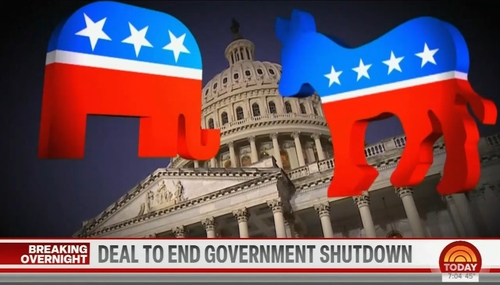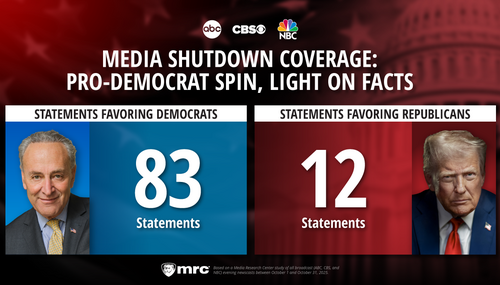
What's Good About Rising Unemployment
What should jump out at the eagle-eyed reader is that headline didn't end with a question mark.
Time senior writer Stephen Gandel was actually making the case that the rising unemployment rate was good news.
Watch just how far a liberal media member is willing to go today to make economic data look favorable for the Party currently in power, and imagine the unlikelihood of such a thing happening if a Republican was in the White House (h/t Rusty Weiss):
The unemployment rate, probably the most famous of economic gauges, may actually be a very bad indicator of how healthy the economy is. [...]
The unemployment rate peaked in late 2009 at just above 10% and has been mostly falling ever since. But the hiring numbers, or less firing numbers, have only been improving recently. So what was going on? The unemployment rate tracks not just how many people have jobs, but how many people are looking for jobs. And, up until August, the number of people looking for jobs was dropping rapidly.
Really? And just how did Gandel reach that conclusion?
Here is the Bureau of Labor Statistics' table of folks 16 and over currently out of the labor force but wanting a job now:
As is plainly visible, the number of folks out of the labor force but wanting work has been fluctuating between 5.61 million and 6.31 million since last August. It did experience a large drop in May, but has pretty much been rising since and is now basically where it was in April and January.
As such, claiming that "up until August, the number of people looking for jobs was dropping rapidly" is utter nonsense not supported by the data. In fact, this number is basically right back to where it was last September.
With that in mind, let's continue:
When people give up looking for work, essentially giving up on the economy, that indicates a really bad drop in confidence, something a recovery feeds on. So the reason the unemployment rate was rising has less to do with more people getting jobs, and more to do with fewer people looking.
Is this really a senior writer?
Let's walk through that last sentence again: "So the reason the unemployment rate was rising has less to do with more people getting jobs..."
Huh? The unemployment rate is a simple arithmetic equation whereby the number of people unemployed is divided by the number of people considered part of the labor force.
Using data just released Friday, there are currently 14.86 million people considered unemployed. The labor force is 154.11 million. This produces an unemployment rate of 9.64 percent.
Now, when people get jobs, the number considered unemployed declines reducing the numerator and therefore decreasing the unemployment rate.
As such, to claim rising unemployment has less to do with more people getting jobs makes absolutely no sense.
On the other hand, the final part of that sentence "and more to do with fewer people looking" needs to be addressed.
"Discouraged workers" - those out of the labor force but wanting a job - can have a huge impact on the unemployment rate.
The way these numbers are calculated, you are only considered unemployed and part of the labor force if you're actively looking for work. As such, when folks give up their search, it reduces the number of unemployed and the labor force by an equal amount.
Once again going back to simple arithmetic, a decrease in the numerator and denominator by an equal amount results in a lower ratio.
2 divided by 3 equals .67; 1 divided by 2 equals .5.
With this in mind, the unemployment rate can decline simply by discouraged job seekers ending their search. This has happened a number of times in the past few years.
Conversely, discouraged workers re-entering the labor force can cause the unemployment rate to rise. An increase in the numerator and denominator by equal amounts produces a higher result.
Gandel claimed this is what happened last month:
According to today's report, 550,000 people entered the workforce in August. That's a huge jump of new people looking for work, either because they haven't worked before or because they decided that this was the month to get back off the couch and start looking. With that many people entering the workforce, the fact that the unemployment number only rose 0.1% is quite a good thing. In fact, more than half of those people who began looking for work in August, or 290,000, landed a job in August.
I agree that this this could be good news, but not necessarily for the same reason.
To make the case that the big jump in the labor force in August was even partially due to discouraged workers starting to look for work again goes against the data as the number of people out of the labor force and wanting work now increased by 86,000.
It goes without saying that if this huge increase in the labor force was caused by discouraged workers re-entering it, the number of discouraged workers wanting work should have declined.
But that's not what happened.
Instead, it appears the August data might have been confounded by seasonalities and the associated adjustments.
As employment watchers are painfully aware, there are seasonal changes in the jobs market that make for wild shifts in the numbers depending on the month.
The summer is a particularly volatile period with teachers out of work, students taking part-time jobs, and graduates getting full-time positions.
To smooth out the data, the Labor Department makes adjustments to the raw figures each month; the headline numbers are always "seasonally adjusted."
However, these manipulations at times present a peculiar picture of the labor market. As Gandel correctly pointed out:
It is possible that coming at the end of the summer an uptick in people looking for work is not as positive as it appears. This is the time of year, after two hot months, when recent graduates start to actually think about their future and send out resumes. And you can image many other out of work people deciding to take off looking for a job in the summer. In August, with the summer ending, some of those people started looking again in earnest.
Exactly. As such, the uptick in the labor force might have had little to do with discouraged workers beginning a new search as he suggested earlier.
In fact, the unadjusted data actually showed a 600,000 decline in the labor force as well as an almost 400,000 decrease in the number of people unemployed.
This means the August data could easily be confounded by seasonalities and their related adjustments thereby offering a fuzzy picture about what any of this means going forward.
This is not to say Friday's report wasn't better than expected.
Over the past couple of weeks, signs had been pointing to a much worse economic conditions leading analysts to ratchet down their estimates for these numbers. As a result, what the BLS released Friday was certainly better than the gloomiest predictions out there.
But, calling this clearly mixed bag "good news" should be left to the administration and the Party currently controlling Congress and not so depicted by a so-called journalist.
This seems especially true given that these exact same numbers would certainly not have been reported with such optimism when George W. Bush was in the White House.
Or have you forgotten the media's favorite economic term during his presidency "jobless recovery?"




